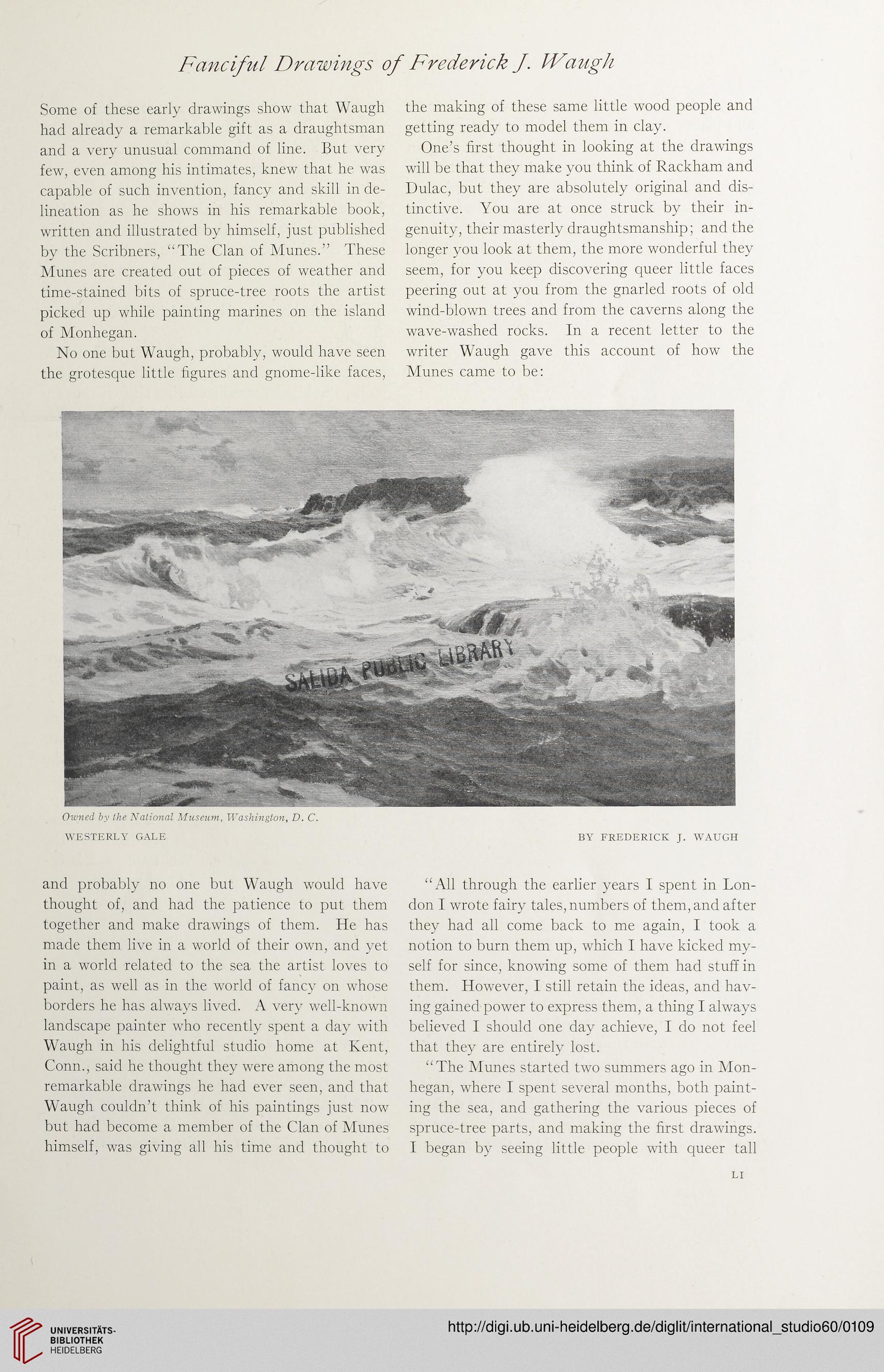Fanciful Drawings of Frederick J. Id7augh
Some of these early drawings show that Waugh
had already a remarkable gift as a draughtsman
and a very unusual command of line. But very
few, even among his intimates, knew that he was
capable of such invention, fancy and skill in de-
lineation as he shows in his remarkable book,
written and illustrated by himself, just published
by the Scribners, “The Clan of Munes.” These
Munes are created out of pieces of weather and
time-stained bits of spruce-tree roots the artist
picked up while painting marines on the island
of Monhegan.
No one but Waugh, probably, would have seen
the grotesque little figures and gnome-like faces,
the making of these same little wood people and
getting ready to model them in clay.
One’s first thought in looking at the drawings
will be that they make you think of Rackham and
Dulac, but they are absolutely original and dis-
tinctive. You are at once struck by their in-
genuity, their masterly draughtsmanship; and the
longer you look at them, the more wonderful they
seem, for you keep discovering queer little faces
peering out at you from the gnarled roots of old
wind-blown trees and from the caverns along the
wave-washed rocks. In a recent letter to the
writer Waugh gave this account of how the
Munes came to be:
Oxvned by the National Museum, Washington, D. C.
WESTERLY GALE BY FREDERICK J. WAUGH
and probably no one but Waugh would have
thought of, and had the patience to put them
together and make drawings of them. He has
made them live in a world of their own, and yet
in a world related to the sea the artist loves to
paint, as well as in the world of fancy on whose
borders he has always lived. A very well-known
landscape painter who recently spent a day with
Waugh in his delightful studio home at Kent,
Conn., said he thought they were among the most
remarkable drawings he had ever seen, and that
Waugh couldn’t think of his paintings just now
but had become a member of the Clan of Munes
himself, was giving all his time and thought to
“All through the earlier years I spent in Lon-
don I wrote fairy tales, numbers of them, and after
they had all come back to me again, I took a
notion to burn them up, which I have kicked my-
self for since, knowing some of them had stuff in
them. However, I still retain the ideas, and hav-
ing gained power to express them, a thing I always
believed I should one day achieve, I do not feel
that they are entirely lost.
“The Munes started two summers ago in Mon-
hegan, where I spent several months, both paint-
ing the sea, and gathering the various pieces of
spruce-tree parts, and making the first drawings.
I began by seeing little people with queer tall
LI
Some of these early drawings show that Waugh
had already a remarkable gift as a draughtsman
and a very unusual command of line. But very
few, even among his intimates, knew that he was
capable of such invention, fancy and skill in de-
lineation as he shows in his remarkable book,
written and illustrated by himself, just published
by the Scribners, “The Clan of Munes.” These
Munes are created out of pieces of weather and
time-stained bits of spruce-tree roots the artist
picked up while painting marines on the island
of Monhegan.
No one but Waugh, probably, would have seen
the grotesque little figures and gnome-like faces,
the making of these same little wood people and
getting ready to model them in clay.
One’s first thought in looking at the drawings
will be that they make you think of Rackham and
Dulac, but they are absolutely original and dis-
tinctive. You are at once struck by their in-
genuity, their masterly draughtsmanship; and the
longer you look at them, the more wonderful they
seem, for you keep discovering queer little faces
peering out at you from the gnarled roots of old
wind-blown trees and from the caverns along the
wave-washed rocks. In a recent letter to the
writer Waugh gave this account of how the
Munes came to be:
Oxvned by the National Museum, Washington, D. C.
WESTERLY GALE BY FREDERICK J. WAUGH
and probably no one but Waugh would have
thought of, and had the patience to put them
together and make drawings of them. He has
made them live in a world of their own, and yet
in a world related to the sea the artist loves to
paint, as well as in the world of fancy on whose
borders he has always lived. A very well-known
landscape painter who recently spent a day with
Waugh in his delightful studio home at Kent,
Conn., said he thought they were among the most
remarkable drawings he had ever seen, and that
Waugh couldn’t think of his paintings just now
but had become a member of the Clan of Munes
himself, was giving all his time and thought to
“All through the earlier years I spent in Lon-
don I wrote fairy tales, numbers of them, and after
they had all come back to me again, I took a
notion to burn them up, which I have kicked my-
self for since, knowing some of them had stuff in
them. However, I still retain the ideas, and hav-
ing gained power to express them, a thing I always
believed I should one day achieve, I do not feel
that they are entirely lost.
“The Munes started two summers ago in Mon-
hegan, where I spent several months, both paint-
ing the sea, and gathering the various pieces of
spruce-tree parts, and making the first drawings.
I began by seeing little people with queer tall
LI




